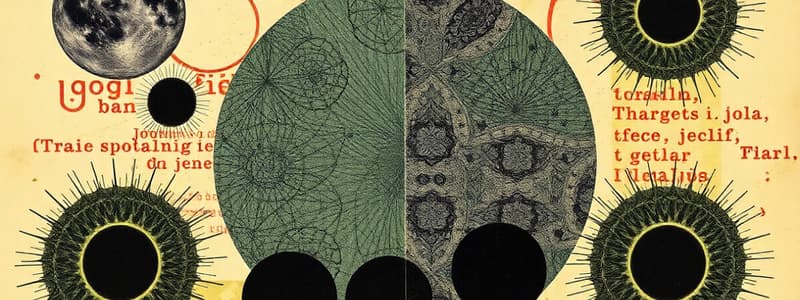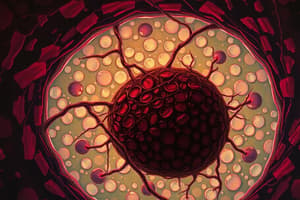Podcast
Questions and Answers
What is chromatin composed of?
What is chromatin composed of?
- Long, threadlike DNA (correct)
- Condensed DNA structures
- Spindle fibers
- Short X-shaped chromosomes
During which phase do chromosomes appear as condensed X-shaped structures?
During which phase do chromosomes appear as condensed X-shaped structures?
- Interphase
- Prophase (correct)
- Telophase
- Meiosis II
What do centrosomes release during cell division?
What do centrosomes release during cell division?
- Chromatin
- Nucleotides
- Spindle fibers (correct)
- DNA strands
What is the main role of spindle fibers in meiosis?
What is the main role of spindle fibers in meiosis?
What is the outcome of meiosis?
What is the outcome of meiosis?
What defines a malignant tumor?
What defines a malignant tumor?
Which statement about crossing over is true?
Which statement about crossing over is true?
Which factors influence the risk of cancer?
Which factors influence the risk of cancer?
Flashcards
Chromatin
Chromatin
Long, threadlike DNA present during interphase.
Chromosomes
Chromosomes
Condensed, X-shaped DNA structures present during prophase.
Centrosomes
Centrosomes
T-shaped structures that release spindle fibers and appear during prophase.
Spindle Fibers
Spindle Fibers
Signup and view all the flashcards
Meiosis
Meiosis
Signup and view all the flashcards
Cancer
Cancer
Signup and view all the flashcards
Malignant Tumor
Malignant Tumor
Signup and view all the flashcards
Metastasis
Metastasis
Signup and view all the flashcards
Study Notes
Cell Division and Cancer
- Chromatin is long, thread-like DNA, present during interphase.
- Chromosomes are condensed DNA in short X shapes, visible during prophase.
- Centrosomes (centrioles) are T-shaped structures appearing during prophase, releasing spindle fibers.
- Spindle fibers are tiny strings attaching to chromosomes and pulling them apart.
- Meiosis is a process where one regular body cell forms four sex cells (reproductive cells). Each daughter cell has half the chromosomes of the original cell and unique chromosomes.
- Cancer is characterized by continuous, uncontrolled cell growth.
- A tumor is a mass of cancer cells.
- Benign tumors stay in their original location and don't interfere with nearby organs.
- Malignant tumors can move, invade surrounding tissue or organs (e.g., via bloodstream), and disrupt organ function.
- Tumors can originate from any cell type.
- Cancer risk involves genetic and lifestyle factors.
- Metastasis is the tumor's movement to other body parts.
- Crossing over is a process that allows different genes to combine in unique ways in reproductive cells.
Meiosis Details
- Meiosis results in four daughter cells, each with half the DNA of the original cell due to crossing over.
- Each daughter cell has unique chromosomes (genetic variation).
Studying That Suits You
Use AI to generate personalized quizzes and flashcards to suit your learning preferences.




